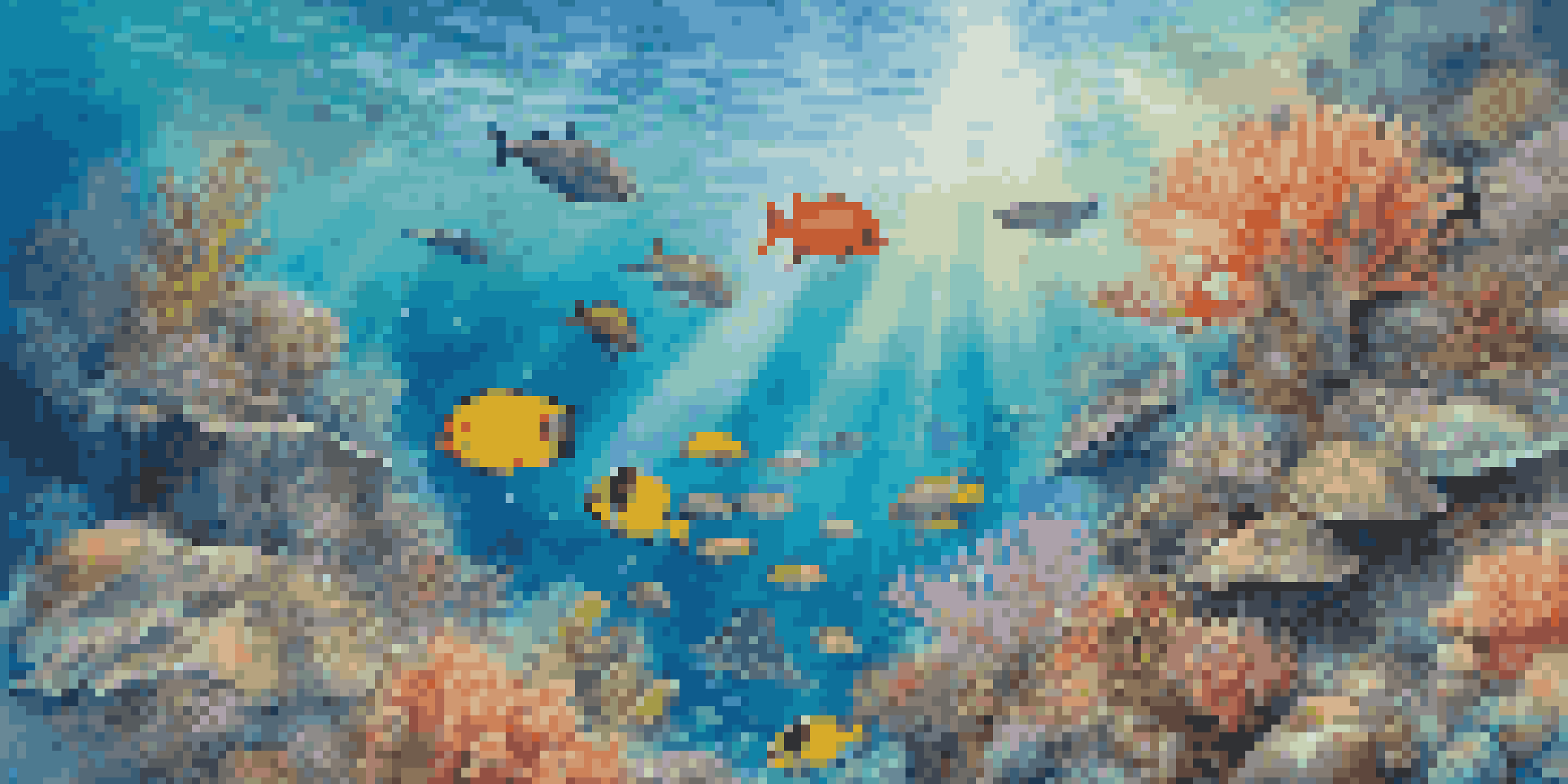Art Exhibitions Dedicated to Ocean Conservation Efforts

The Intersection of Art and Ocean Conservation
Art and ocean conservation may seem like unlikely companions, but they share a powerful connection. Artists have the unique ability to evoke emotions and provoke thought, making them vital advocates for environmental issues. By showcasing the beauty and fragility of marine life, art exhibitions can inspire audiences to take action in conservation efforts.
Art is not a mirror held up to reality, but a hammer with which to shape it.
For instance, an artist might create a stunning underwater mural that highlights the vibrant ecosystems found beneath the waves. This visual storytelling captivates viewers and encourages them to reflect on how their actions impact the ocean. By bridging the gap between creativity and activism, art becomes a vital tool for raising awareness about ocean conservation.
Moreover, these exhibitions often invite collaboration with scientists and conservationists, enriching the narrative around ocean health. When art becomes a platform for dialogue, it fosters a deeper understanding of the challenges our oceans face and the urgent need for collective action.
Notable Ocean Conservation Art Exhibitions
Around the world, several art exhibitions have made significant strides in promoting ocean conservation. One standout example is the 'Ocean Heroes' exhibition, which showcased the works of artists dedicated to marine protection. Each piece illustrated a different aspect of ocean life, from coral reefs to endangered species, creating a vivid tapestry of our planet's aquatic wonders.

Another remarkable exhibition, 'The Blue Planet,' featured installations made entirely from ocean plastic waste. By transforming trash into art, the exhibit drew attention to the pollution crisis affecting our seas. Visitors were left with a stark reminder of the impact of plastic on marine life, inspiring them to make more conscious choices in their own lives.
Art Inspires Ocean Conservation
Art exhibitions evoke emotions and raise awareness about the beauty and fragility of marine life, motivating audiences to engage in conservation efforts.
These exhibitions not only showcase incredible artwork but also provide educational resources and workshops. Many include discussions with marine biologists and conservationists, offering attendees a chance to learn more about how they can contribute to ocean conservation efforts.
The Role of Technology in Ocean Conservation Art
In today's digital age, technology plays a crucial role in enhancing the impact of art exhibitions dedicated to ocean conservation. Virtual reality experiences allow audiences to immerse themselves in underwater ecosystems, offering a firsthand glimpse of the beauty that lies beneath the surface. This interactive approach captivates viewers and promotes a deeper emotional connection to the ocean.
To cherish what remains of the Earth and to foster its renewal is our only legitimate hope of survival.
Additionally, artists are using innovative techniques such as augmented reality to bring their work to life. Imagine pointing your smartphone at a painting of a coral reef and watching it animate, illustrating the vibrant marine life within. This blend of art and technology fosters engagement and encourages discussions about conservation in a fresh, modern way.
Furthermore, social media platforms provide a powerful outlet for artists and organizations to spread their message beyond the exhibition walls. By sharing captivating images and stories online, they can reach wider audiences and inspire collective action towards ocean conservation.
Community Involvement in Ocean Conservation Art
Community engagement is essential in amplifying the message of ocean conservation art exhibitions. Many events invite local artists and schools to participate, fostering a sense of ownership and pride in the shared goal of protecting our oceans. When communities come together to create art, it strengthens their bond with the marine environment.
For example, community mural projects that focus on ocean themes can transform public spaces while educating residents about marine conservation. These collaborative efforts encourage people to reflect on their relationship with the ocean and how they can contribute to its protection. It's a beautiful reminder that art can unite people for a common cause.
Community Engagement is Key
Involving local artists and communities in ocean conservation projects fosters pride and strengthens the bond between people and the marine environment.
Moreover, workshops and educational programs associated with exhibitions can empower individuals with knowledge and tools to advocate for ocean health. By nurturing creative expression and environmental consciousness, these initiatives inspire lasting change at the grassroots level.
Art as a Catalyst for Change
Art exhibitions dedicated to ocean conservation serve as powerful catalysts for change. By highlighting the beauty and diversity of marine ecosystems, they inspire visitors to consider their role in protecting these natural treasures. When people experience art that resonates with them emotionally, they are more likely to take action in their own lives.
For instance, an artist's depiction of a dying coral reef might spur an individual to reduce their plastic consumption or volunteer for a coastal cleanup. This ripple effect illustrates how art can move hearts and minds, leading to tangible changes in behavior. The emotional connection fostered by these exhibitions can ignite a passion for conservation that extends far beyond the gallery walls.
Additionally, many exhibitions partner with conservation organizations to provide actionable steps for attendees. Whether it's signing petitions, participating in local initiatives, or supporting sustainable practices, these opportunities empower individuals to contribute to the cause, making them feel like active participants in the fight for ocean health.
Challenges Faced by Ocean Conservation Art Exhibitions
Despite their positive impact, ocean conservation art exhibitions face several challenges. Funding can be a major hurdle, as artists and organizers often rely on grants and donations to bring their visions to life. Without adequate financial support, it can be difficult to create high-quality exhibits that effectively convey the urgency of ocean conservation.
Moreover, ensuring a diverse range of voices and perspectives in these exhibitions is crucial. It's important to include artists from various backgrounds and cultures, as they may offer unique insights into how ocean health affects their communities. By embracing diverse narratives, exhibitions can resonate with a broader audience and foster a more inclusive conversation about conservation.
Technology Enhances Artistic Impact
Innovative technologies like virtual and augmented reality in art exhibitions create immersive experiences that deepen emotional connections to ocean conservation.
Finally, sustaining public interest can be challenging in a world filled with distractions. To combat this, organizers must continuously innovate and adapt their approaches, exploring new themes and integrating technology to keep audiences engaged. By staying relevant and dynamic, these exhibitions can continue to inspire action for ocean conservation.
The Future of Art and Ocean Conservation
Looking ahead, the future of art exhibitions focused on ocean conservation appears promising. As awareness of environmental issues continues to grow, artists are increasingly using their platforms to advocate for change. This trend suggests that we can expect more creative and impactful exhibitions that address the pressing challenges facing our oceans.
Furthermore, collaborations between artists, scientists, and conservation organizations are likely to become more common. This partnership can lead to innovative projects that blend art with scientific research, creating compelling narratives that educate and inspire action. By working together, these groups can amplify their efforts and reach wider audiences.

Ultimately, the intersection of art and ocean conservation represents a powerful movement that has the potential to drive meaningful change. As more people engage with these exhibitions, we can hope for a future where the beauty of our oceans is celebrated, protected, and cherished for generations to come.